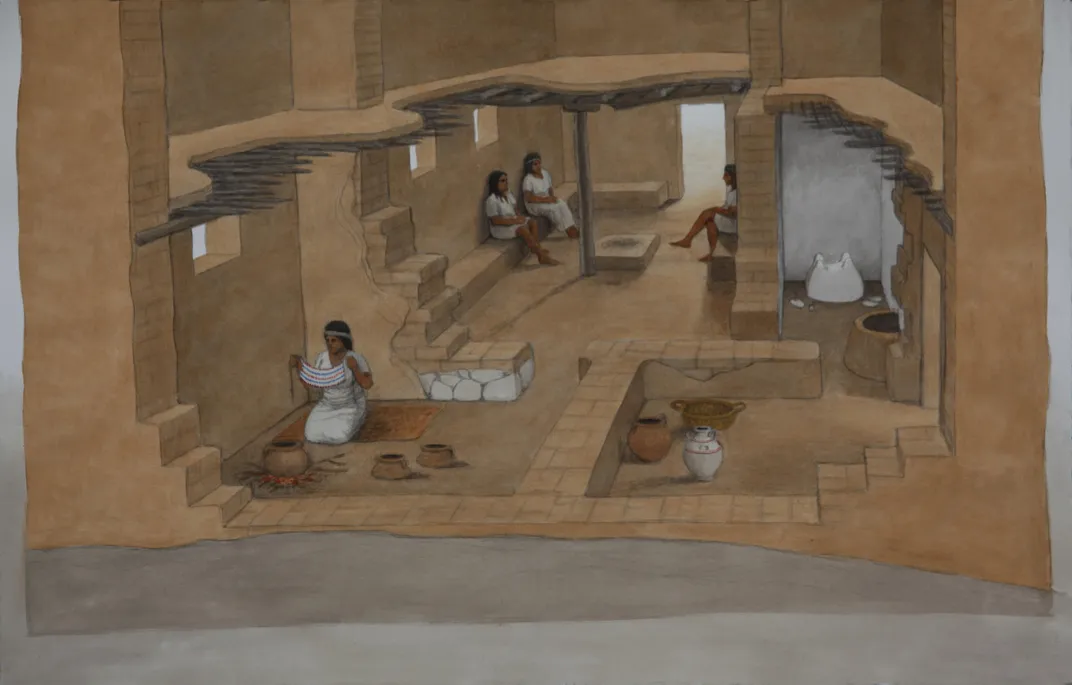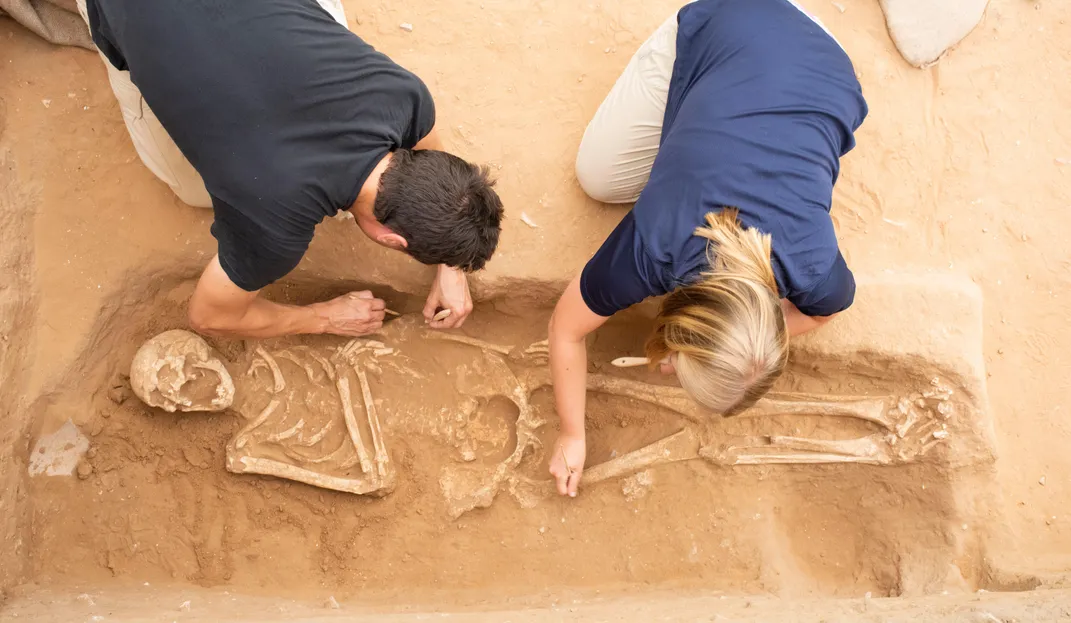Ancient DNA Sheds New Light on the Biblical Philistines
A team of scientists sequenced genomes from people who lived in a port city on the Mediterranean coast of Israel between the 12th and 8th centuries B.C.
/https://tf-cmsv2-smithsonianmag-media.s3.amazonaws.com/filer/84/3a/843a6f19-950c-4df0-87b3-07125f416cb6/_dsc9071.jpg)
Sometime in the 12th century B.C., a family in the ancient port city of Ashkelon, in what is today Israel, mourned the loss of a child. But they didn’t go to the city’s cemetery. Instead, they dug a small pit in the dirt floor of their home and buried the infant right in the place where they lived.
That child’s DNA is now helping scholars trace the origins of the Philistines, a long-standing, somewhat contentious mystery. In accounts from the Hebrew Bible, the Philistines appear mostly as villainous enemies of the Israelites. They sent Delilah to cut the hair of the Israelite leader Samson and thus stripped him of his power. Goliath, the giant slain by David, was a Philistine. The Philistines’ reputation as a hostile, war-mongering, hedonistic tribe became so pervasive that “philistine” is still sometimes lobbed as an insult for an uncultured or crass person.
But who were the Philistines, exactly? In the Bible, ancient cities like Ashkelon, Ashdod and Ekron were mentioned as Philistine strongholds. In the 19th and 20th centuries, scholars finally started to piece together a distinct archaeological record of Philistine culture. Excavations revealed that these cities saw the emergence of new architecture and artifacts at the beginning of the Iron Age, around 1200 B.C., signaling the arrival of the Philistines. Pottery found at Philistine archaeological sites, for example, appeared to have been made locally, but looked strikingly like wares created by Aegean cultures such as the Mycenaeans, who built their civilization in what is now mainland Greece. And the Bible mentions “Caphtor,” or Crete, as the origin place of the Philistines.
Historians also know that, around the time these changes occur in the archaeological record, civilizations in the Aegean and Eastern Mediterranean were collapsing. The Philistines are written about in Egyptian hieroglyphs, where they are referred to as the Peleset, among the tribes of “Sea Peoples” said to have battled against Pharaoh Ramses III around 1180 B.C. Meanwhile, other scholars have suggested that the Philistines were in fact a local tribe, or one that came from present-day Turkey or Syria.

Now, researchers have extracted DNA from the remains of 10 individuals, including four infants, who were buried at Ashkelon during the Bronze Age and Iron Age. The results, which were published today in the journal Science Advances, suggest the Philistines indeed migrated to the Middle East from southern Europe.
“This is an excellent example of a case where advances in science have helped us answer a question that has been long debated by archaeologists and ancient historians,” says Eric Cline, a professor at George Washington University and director of the Capitol Archaeology Institute, who was not involved in the study.
The new study stems from a discovery in 2013 of a cemetery with more than 200 burials contemporary with the Philistine settlement at Ashkelon just outside the ancient city walls. The cemetery, which was used during the late Iron Age, between the 11th and 8th centuries B.C., was the first Philistine burial ground ever found. The archaeologists documented burial practices that were distinct from the Philistines' Canaanite predecessors and their Egyptian neighbors. For example, in several cases, little jugs of perfume were tucked near the head of the deceased. Finding Philistine human remains also meant there might be potential to find Philistine DNA.
“We knew of the revolution in paleogenetics, and the way people were able to gather from a single individual hundreds of thousands of data points,” says Daniel Master, the director of the excavations and a professor of archaeology at Wheaton College in Illinois.
Getting DNA from the newly discovered human remains at Ashkelon, however, proved tricky. The southern Levant does not have a favorable climate for the preservation of DNA, which can break down when it’s too warm or humid, says Michal Feldman, who studies archaeogenetics at the Max Planck Institute for the Science of Human History in Germany, and is the lead author of the new report. Nonetheless, the researchers were able to sequence the whole genome of three individuals from the cemetery.
/https://tf-cmsv2-smithsonianmag-media.s3.amazonaws.com/filer/c5/53/c5534735-30b4-457e-b1da-432e84787863/205015.jpg)
To establish a baseline for the local genetic profile, the researchers also sequenced genomes from the remains of three Canaanites who had been buried in Ashkelon during the Bronze Age, before the alleged arrival of the Philistines. The team was also able to extract DNA from the remains of four infants who had previously been found in Philistine houses during excavations between 1997 and 2013. These children were buried in the Iron Age, in the 12th or 11th century, shortly after the Philistines supposed arrival in the region.
The results showed that the four Iron Age infants all had some genetic signatures matching those seen in Iron Age populations from Greece, Spain and Sardinia. “There was some gene flow coming in that was not there before,” Feldman says.
The researchers interpreted these results as evidence that migration indeed occurred at the end of the Bronze Age or during the early Iron Age. If that’s true, the infants may have been the grandchildren or great-grandchildren of the first Philistines to arrive in Canaan.
Intriguingly, their DNA already had a mixture of southern European and local signatures, suggesting that within a few generations the Philistines were marrying into the local population. In fact, the European signatures were not detectable at all in the individuals buried a few centuries later in the Philistine cemetery. Genetically, by then the Philistines looked like Canaanites. That fact in itself offers additional information about Philistine culture. “When they came, they did not have any kind of taboo or prohibition against marrying into other groups around them,” Master says. Nor, it would seem, did other groups categorically have that taboo about them, either. "One of the things that I think it shows is that the world was really complicated, whether we’re talking about genetics or identity or language or culture, and things are changing all the time," he adds.

Cline cautions that it’s always best to be careful about connecting new genetic data to cultures and historic events, and the researchers recognize that if they had only looked at the DNA from the Philistine cemetery, they might have come up with a totally different story about the identity of the Philistines.
“Our history appears to be full of these transient pulses of genetic mixing that disappear without a trace,” says Marc Haber, a geneticist at the U.K.’s Wellcome Sanger Institute, who was not involved in the study. Haber has previously found evidence of “pulses” of gene flows from Europe to the Near East during the Middle Ages, which disappeared centuries later. “Ancient DNA has the power to look deep into the past and give us information on events that we knew little or nothing about.”
The findings are a good reminder, Feldman says, that a person’s culture or ethnicity is not the same as their DNA. “In this situation, you have foreign people coming in with a slightly different genetic makeup, and their influence, genetically, is very short. It doesn’t leave a long-lasting impact, but culturally they made an impact that lasted for many years.”